

Khanacademy. Anniversary of the Protestant Reformation: 500 Years Later. The man who started it all: German theologian and religious reformer Martin Luther (1483-1546) Imagno/Getty Images hide caption toggle caption Imagno/Getty Images The man who started it all: German theologian and religious reformer Martin Luther (1483-1546) Five hundred years after a rebellious act by a single German monk divided the Christian world, religious leaders on both sides of that split have finally agreed their churches share responsibility for the historic rupture.

On Oct. 31, 1517, an outspoken university lecturer and Augustinian monk named Martin Luther posted a list of objections to the dominant Roman Catholic beliefs and practices of his time. Worshippers gather at the Schlosskirche church in Wittenberg, Germany, where Martin Luther is thought to have nailed his "95 Theses" to the church's doors in 1517. Sean Gallup/Getty Images For their part, Lutheran leaders are approaching the Reformation anniversary with comparable humility. Jim Pringle/Associated Press. Introduction to the Protestant Reformation: Setting the stage (video)
History - An Overview of the Reformation. Copernicus and the Church: What the history books don't say. Legend has it that Nicolaus Copernicus and the church were at odds over his development of the heliocentric theory, a principle that disputed the widely held belief that Earth was the center of the universe.
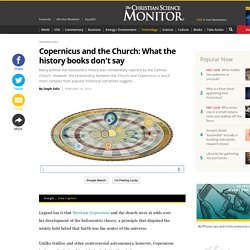
Unlike Galileo and other controversial astronomers, however, Copernicus had a good relationship with the Catholic Church. It may come as a surprise, considering the Church banned Copernicus' "Des revolutionibus" for more than 200 years. Copernicus was actually respected as a canon and regarded as a renowned astronomer. Contrary to popular belief, the Church accepted Copernicus' heliocentric theory before a wave of Protestant opposition led the Church to ban Copernican views in the 17th century.
The Role of Religion in the Scientific Revolution - The Objective Standard. Harry Elkins Widener Collection - Houghton Library. Harry Elkins Widener Collection The Gutenberg Bible Biblia Latina, [the “Gutenberg Bible”].

Mainz: Johann Gutenberg, 1454-55. First page of Genesis. Medici: Godfathers of the Renaissance . Renaissance . Heresy. By the turn of the 15th century, the Catholic Church was divided and in chaos.
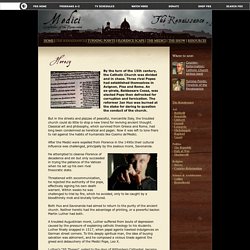
Three rival Popes had established themselves in Avignon, Pisa and Rome. An ex-pirate, Baldassare Cossa, was elected Pope then defrocked for corruption and fornication. The reformer Jan Hus was burned at the stake for daring to question the conduct of the church. But in the streets and piazzas of peaceful, mercantile Italy, the troubled church could do little to stop a new trend for reviving ancient thought. Classical art and philosophy, which survived from Greece and Rome, had long been condemned as heretical and pagan. Medici: Godfathers of the Renaissance . Renaissance . Counter Reformation. Throughout the middle ages the Catholic Church sunk deeper into a pit of scandal and corruption.
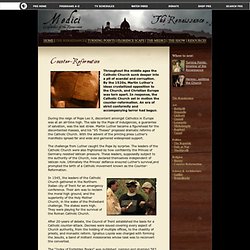
By the 1520s, Martin Luther's ideas crystallized opposition to the Church, and Christian Europe was torn apart. In response, the Catholic Church set in motion the counter-reformation. An era of strict conformity and accompanying terror had begun. During the reign of Pope Leo X, discontent amongst Catholics in Europe was at an all-time high. Log In. Luther’s pamphlets were distributed at markets and taken by cart to other cities and read aloud publicly for those unable to read, Dr.

Emmerling said. “We like to say if Martin Luther was alive today, he would use Twitter,” she added. Many works on view are from the workshop of Lucas Cranach the Elder, an artist who was Luther’s neighbor and friend and with whom he frequently collaborated. “The ideas of the Reformation happened because of Luther’s words, and because of all the imagery that went along with it,” said Dr. McQuillen of the Morgan. Dr. Such an act was not revolutionary; it was just one more event in the daily life of a university, Dr. He said he hoped that viewers would leave with an understanding of the scale of Luther’s undertaking and that it was not only what Luther said, but how he said it.
Photo. Ninety-five Theses. Martin Luther posts 95 theses - Oct 31, 1517. Also on this day American Revolution On this day in 1776, in his first speech before British Parliament since the leaders of the American Revolution came together to sign of the Declaration of Independence that summer, King George III acknowledges that all was not going well for Britain in the war with the United States.
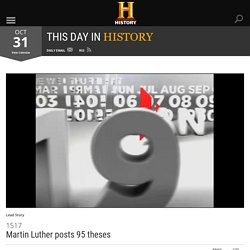
In his... Automotive On October 31, 1957, the Japanese car company Toyota establishes its U.S. headquarters in an old Rambler dealership in Hollywood, California. Civil War Citing failing health, General Winfield Scott, commander of the Union forces, retires from service on this day in 1861. Cold War Two days after Israeli sent forces into Egypt initiating the Suez Crisis, British and French military forces join them in the canal zone to try to retake the canal. Crime. Book of Concord. Disputation of Doctor Martin Luther on the Power and Efficacy of Indulgences by Dr.

Martin Luther (1517) Published in: Martin Luther and the 95 Theses - Facts & Summary. Committed to the idea that salvation could be reached through faith and by divine grace only, Luther vigorously objected to the corrupt practice of selling indulgences.

German religious leader. Luther, Martin. German theologian, professor, pastor, and church reformer.
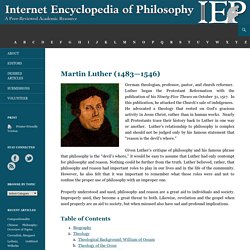
Luther began the Protestant Reformation with the publication of his Ninety-Five Theses on October 31, 1517. In this publication, he attacked the Church’s sale of indulgences. He advocated a theology that rested on God’s gracious activity in Jesus Christ, rather than in human works. Nearly all Protestants trace their history back to Luther in one way or another. Luther’s relationship to philosophy is complex and should not be judged only by his famous statement that “reason is the devil’s whore.” Given Luther’s critique of philosophy and his famous phrase that philosophy is the “devil’s whore,” it would be easy to assume that Luther had only contempt for philosophy and reason. Properly understood and used, philosophy and reason are a great aid to individuals and society.
Table of Contents. Martin Luther. Martin Luther and the 95 Theses - Facts & Summary. Martin Luther - Theologian. Theologian Martin Luther forever changed Christianity when he began the Protestant Reformation in 16th-century Europe. Synopsis Born in Germany in 1483, Martin Luther became one of the most influential figures in Christian history when he began the Protestant Reformation in the 16th century. He called into question some of the basic tenets of Roman Catholicism, and his followers soon split from the Roman Catholic Church to begin the Protestant tradition. Early Life Martin Luther was born on November 10, 1483, in Eisleben, Saxony, in modern southeast Germany.
Hans Luther knew that mining was a tough business and wanted his promising son to have better and become a lawyer.